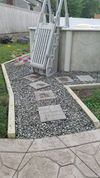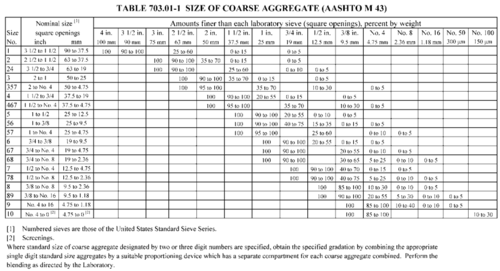Gravel is used in many places around pools.
Where is Gravel Used Around Pools?
Gravel is used for backfill for pools. Gravel is permeable and helps in drainage in the areas it is used. Gravel packs very well and is preferable to sand or dirt. Gravel is easier to use then sand that needs to be washed in or dirt that needs to sit for weeks or months to reach a desired compaction rate.
Gravel is also used in well points
What Are the Different Types of Gravel?
There are different types and sizes or gravel:
- 89 stone is a small size used as the base to set a pool on and to backfill the step and seating areas. 89 stone can fill tight areas that may leave a void area of material.
- 57 stone is about a half inch in size and is used to backfill the side walls of a pool. 57 stone works well locking together for good compaction when it is dropped into the overdig area around the pool. Its 95% compacted out of the bucket. A light hand tamp or plate compactor and you are good.[1]
Other types of rock used around pools are:
- 3/4" clean (what everyone calls "gravel" in some spots (mainly for drainage in areas you cannot see)
- 3/8" grey pea gravel in some areas - like under the swing set.
- 3/8" yellow pea gravel around some trees
- 2" egg rock around the pool. It is large enough to stay in place, but it nests well. The rounded edges make it easy to pull any stray weeds that get into it.
- Pea gravel is most often recommended for the base of fiberglass pools. Get a tamper in there on the base material, and compact in lifts.[2]
- Pea gravel gets everywhere - it is too small to put around the pool. It gets knocked out of wherever you put it too easily. It works great under a swing set, because a good layer of pea gravel provides a cushioned surface for around swings and play structures.
- Eastern Sunrise is pretty, it is it like volcanic rock. It is unstable to walk on, and dogs hates it (it hurts paws). It is also a pain to weed in (because it is so sharp)
- Crusher run is stone dust and 57 stone mixed. Crusher dust is stone dust that's better than sand. Sand is round tiny marbles and will wash with rain. Stone dust or concrete sand looks like rice under a magnifying glass it locks together and wont wash easily.[3]
Typically a crushed stone is preferred for structural purposes and a round stone is preferred for drainage and aesthetic purposes. The sharp angles of crushed stone will lock together better for more stability.[4]
When buying stone, bulk is SO much cheaper than bags. If you have a need for any sort of quantity of stone, look into bulk delivery. Or, even better, if you can get it yourself, its even cheaper. Just be careful, stone is heavy.[5]
Why is 57 Stone Named 57?
Because it has both AASHTO size #5 & size #7 rocks. Probably doesn't help explain it much, but trying to understand or explain the naming conventions for AASHTO aggregate sizing is an exercise in frustration.[6]
How Much Gravel Will You Need?
Try some of these calculators:
Does Gravel Need to be Compacted?
Any gravel you put down that is not clean will need to be compacted with a plate. Only sharp angular rock like #57 known as 3/4 clean can be put down without a machine compact. Anything with mixed sizes and fines mixed in like road base will settle if not compacted.
Gravel in Vinyl In-Ground Pool Builds
- Raise the bottom using clean 3/4 gravel.[7]
- Use it to fine tune the bottom and then use 1/4 stone to fine tune the panels.
- Have them dump close to the pool and use the bucket to bring it in. Cover the whole shallow end and shelf and use it for the backfill of wall panels.
- Don't use concrete to backfill.
- If you have clay use a geotextile fabric on top of your compacted sub base then add gravel base for your decking.
Gravel for Drainage Around a Pool
- If a concrete pool put perforated hard pipe around the base and backfill with clean gravel then drop to a 10" sump pit and pipe it underground.[8]
- Don't forget to run electric to the pit you do not want to be running extension cords. 1/3 hp is enough for a drainage pit you can play with the height of pump in pit later to keep it from running 24/7.
- Location doesn't matter the drainage pipe will bring water to where you want it.
- Do not use corrugated flex pipe no matter what you do only SDR rated drain pipe.
- Wrap the base dirt and up the wall with a woven septic type fabric and then fold over to the pool wall a foot or more up on the gravel. Over time the fines in soil will migrate and 10yrs down the road the voids in gravel will ne filled with silt and not perc as well. If you have sand it will not be as bad as dirt but will happen.
- When you protect drainage pipe you protect its gravel too just as important as pipe
.
- ↑ https://www.troublefreepool.com/threads/screwed-up-my-elevation-any-ideas.193673/post-1707788
- ↑ https://www.troublefreepool.com/threads/2018-fiberglass-install-uxbridge-ointario.155388/post-1388162
- ↑ https://www.troublefreepool.com/threads/oh-no-what-have-i-done-need-install-advice.182999/post-1651888
- ↑ https://www.troublefreepool.com/threads/confused-by-gravel-types.193859/#post-1708753
- ↑ https://www.troublefreepool.com/threads/what-is-the-best-material-to-put-around-an-above-ground-pool.126777/post-1121430
- ↑ https://www.troublefreepool.com/threads/confused-by-gravel-types.193859/post-1709099
- ↑ https://www.troublefreepool.com/threads/screwed-up-my-elevation-any-ideas.193673/post-1707364
- ↑ https://www.troublefreepool.com/threads/where-should-we-put-the-well-point-by-the-pool-high-water-table.181519/post-1604931



